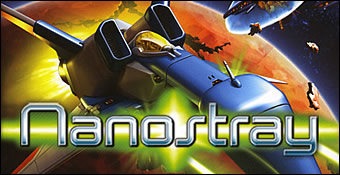With the release of the Nintendo DS in 2004 came a new STG out of Shin'en's workshop to accompany it in 2005. Rather than reuse the Iridion license, we received Nanostray instead, a very similar shmup with a significant graphical overhaul. Gone are the rendered backgrounds and awkward sprite stretching; sleek polygonal ships strafing at high speeds now rule the battlefield. The action is faster and the enemies hit harder in Nanostray, making it a pretty irresistible package for shmup fans thirsting for a portable shooter, as long as you can get over some the eccentricities.
Out of its predecessors, Nanostray stays the closest to Iridion II (unsurprisingly). The camera angle, bombs, multiple power-ups and general difficulty adheres to the guidelines already printed out, though in some ways Nanostray is a bit more intense. More bullets are present on the screen at once, and your own arsenal has been heavily upgraded; each of the weapons & their respective energized shots are well balanced and have noticeable uses, whether it be the boss-crushing side shot or the handy undulating lightning emission. You'll find yourself switching up shot-types a lot more often, though the process of doing so has been made unfortunately complicated.
Since the Nintendo DS's primary feature is the duplicate touch screen, some awkward touch controls are thrown in for good measure. To view your remaining power or to change your weapons, you have to consult the bottom screen, which tends to split your focus in pivotal moments—the power-ups suffer the most from this, as their individual windows of opportunity can be very brief. I would've preferred L&R to be designated for this purpose (they serve no actual function in the game), though it's not entirely too terrible once you get nimble enough at tapping the colored icons between safe spots.
Since the Nintendo DS's primary feature is the duplicate touch screen, some awkward touch controls are thrown in for good measure. To view your remaining power or to change your weapons, you have to consult the bottom screen, which tends to split your focus in pivotal moments—the power-ups suffer the most from this, as their individual windows of opportunity can be very brief. I would've preferred L&R to be designated for this purpose (they serve no actual function in the game), though it's not entirely too terrible once you get nimble enough at tapping the colored icons between safe spots.
The new hardware makes itself known not only in the controls and crisp visuals, but also the speed of the game. Slowdown aside, the game moves quick and plays quick, being closer to an arcade-style shmup than the Iridion games ever felt. I'm a bit sad to see the rendered backgrounds gone, but the game is obviously better for ditching its wonky handling of sprites, and still looks quite nice even today. With that said about the graphics, I'm not entirely sure about how I feel on the music—despite Manfred Linzner's continued work on Shin'en's titles, the tracks here are less distinctive and catchy than the GBA games. Even sadder is that the option is missing to fiddle with audio levels, as the current mixing allows enemy explosions to tower over the tunes.
Nevertheless, the entire package still glitters at the end of the day. The levels and waves of enemies are varied, the challenges can be a thrill to tackle, the bosses provide a delightful (and dreadful) spectacle, and the game only has a few other kinks outside of what I've mentioned (like how the playing field is more limited than the player thinks it is). The energized shots are a great addition to the series, and the leniency of infinite continues in the Normal mode ensure that even the greenest of amateurs can see this journey through to its end. It's just fun stuff overall.
Nanostray feels very akin to Iridion II, but it's a lot less graceful—more wild and uncaring—than its predecessor. This makes the game personally more engaging, and even with its short length it provides a satiating experience. The Advanced difficulty hits the sweet spot between being punishing and too lenient, and the challenge mode adds a teensy bit of variation in case you ever get bored of the campaign. Nanostray won't find itself among the ranks of other elite STGs like Gradius or Mushihimesama, but it does a damn fine job at what it sets out to do.
---------------------
Images obtained from: jeuxvideo.com, journaldugamer.com, archaic.fr
Images obtained from: jeuxvideo.com, journaldugamer.com, archaic.fr




No comments:
Post a Comment